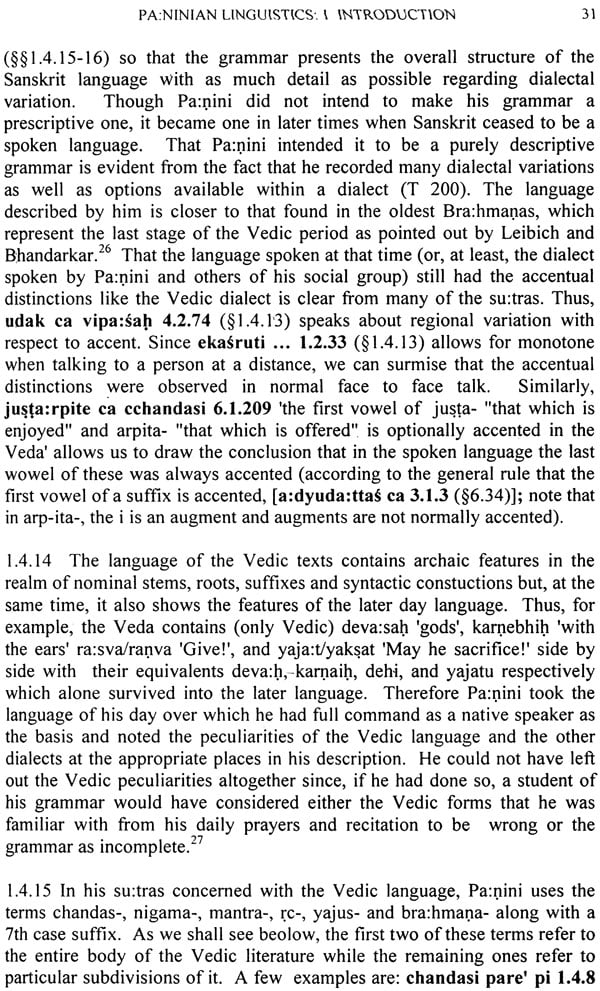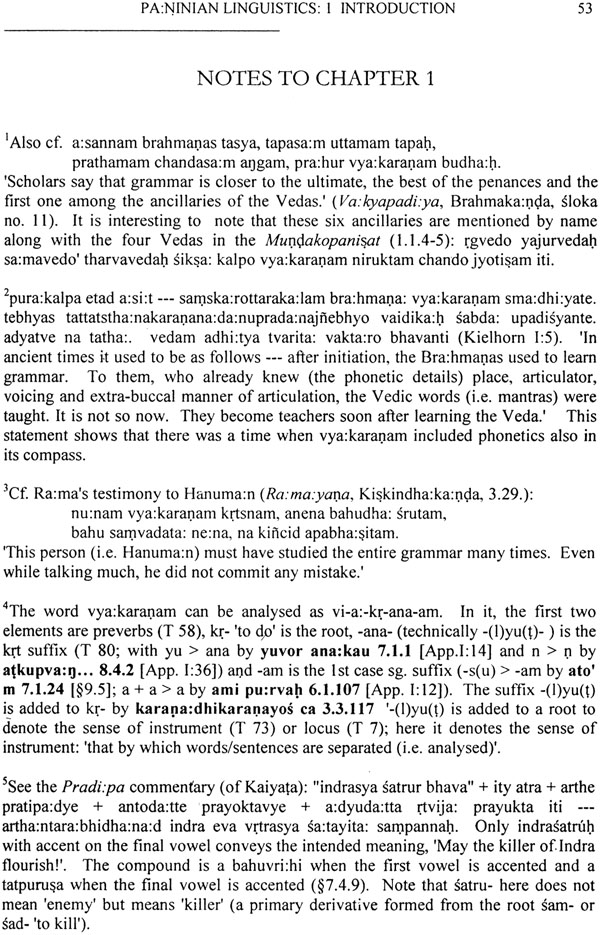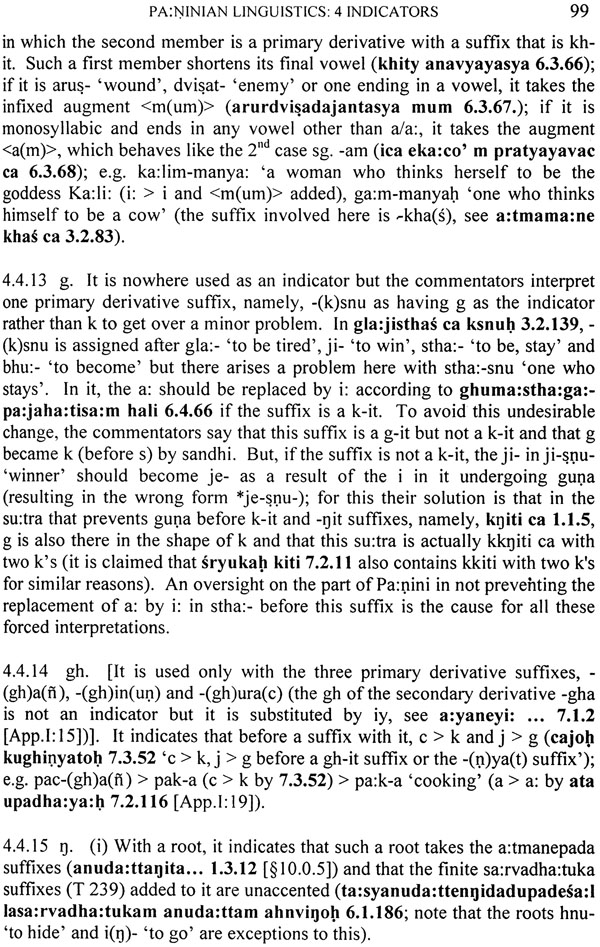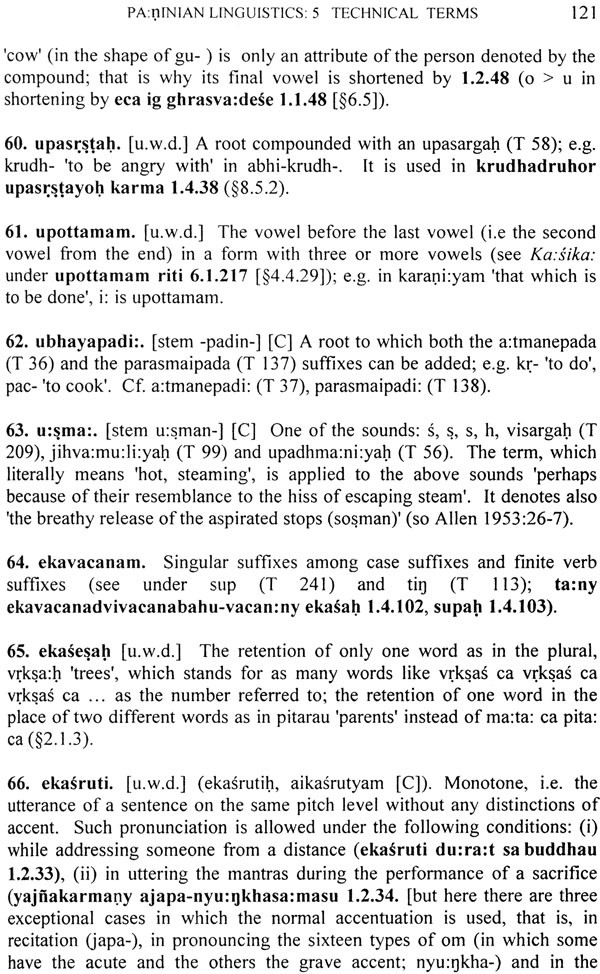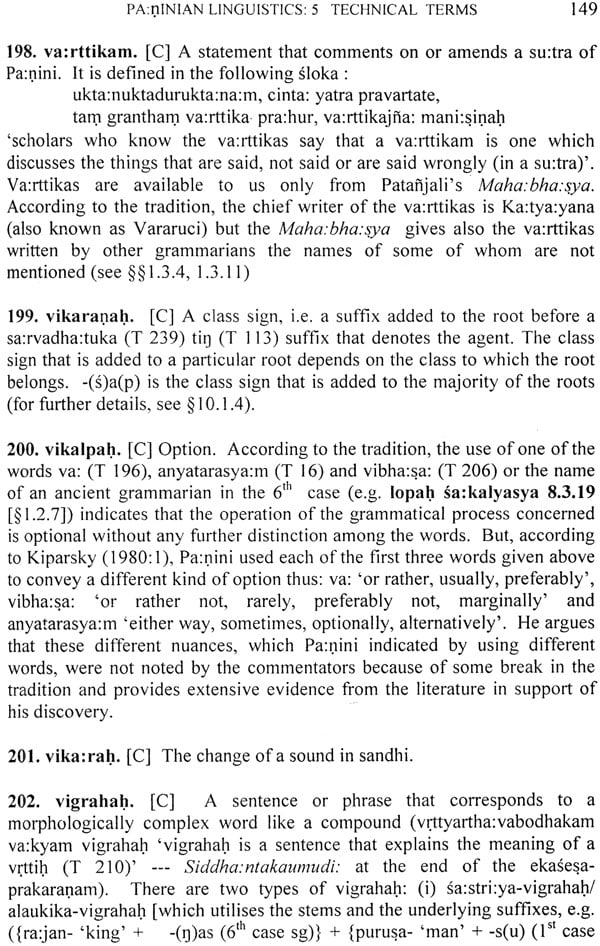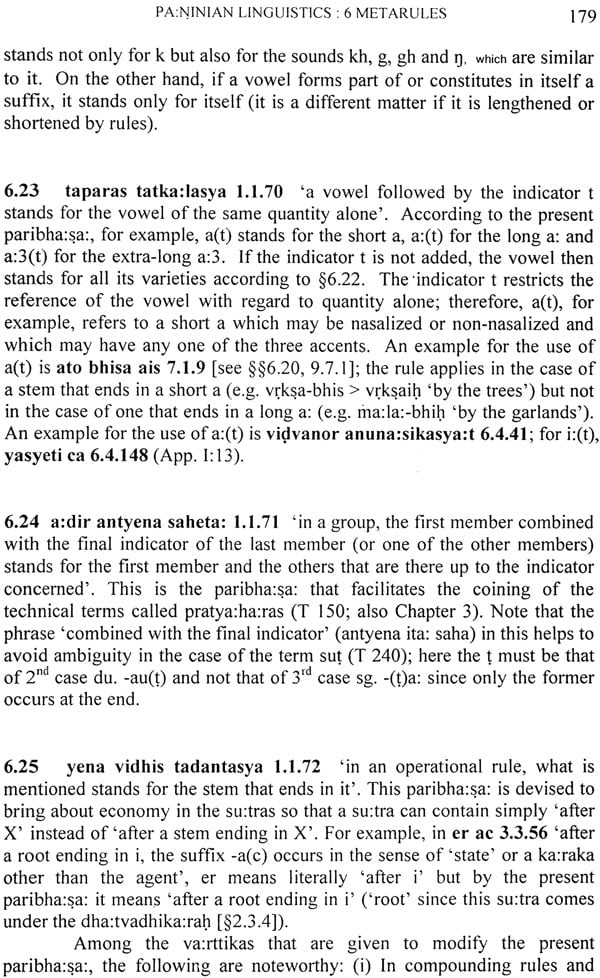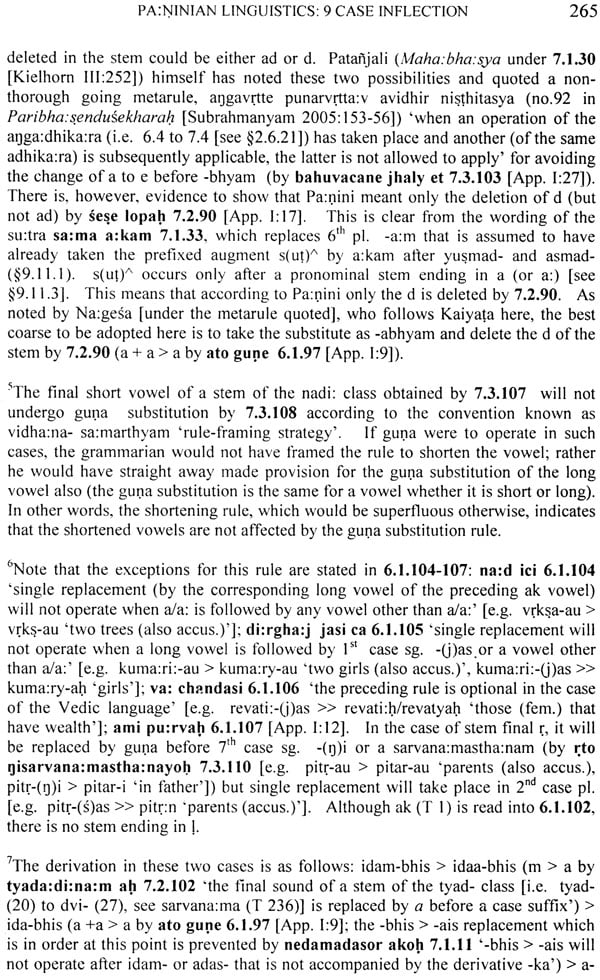
Pa:Ninian Linguistics
Book Specification
| Item Code: | NAJ211 |
| Author: | P.S. Subrahmanyam |
| Publisher: | Rashtriya Sanskrit Vidyapeetha, Tirupati |
| Language: | English |
| Edition: | 2010 |
| Pages: | 393 |
| Cover: | Hardcover |
| Other Details | 10 inch X 6.5 inch |
| Weight | 900 gm |
Book Description

About the Book
This book provides a lucid introduction to Pa:nini’s Asta:dhya:yi., the ancient grammar of Sanskrit with a theoretical basis which is awe-inspiring even in the present times. Many studies have already appeared on it but most of them presuppose some basic knowledge of the work on the part of the reader. The present work is designed to impart such a basic knowledge to the beginner in ten chapters. The topics surveyed in the work include terms for sound groups based on the Sivasu:tras, the organisation of the topics in the eight Adhya:yas (chapters), the functions of the indicators and metarules that help to interpret the actual function rules. About 250 technical terms used in the work are explained with examples. Besides providing basic information on the Asta:dhya:yi: and the Pa:ninian school, it illustrates the methodology adopted by Pa:nini taking up for detailed investigation some of the important areas like the ka:raka system, case system tied up with the previous one and the finite verb system. Throughout the work the explanations and definitions are accompanied by the relevant su:tras. In almost all the cases, the full details of the step by step derivation of a word from the stage of underlying elements to the form of the actual language is provided; the derivation involves, among other things, the addition of a basic suffix, its replacement, if any, by its variant assigned under specific conditions, the operation of possible morphophonemic rules and the regulation of accent.
In view of the unceasing interest of linguists of the earlier as well as the present generations in the grammatical mechanism of the Asta:dhya:yi., it is hoped that the present work will serve as a basic tool for linguists and Sanskrit scholars in their endeavour to understand this ancient but comprehensive and technically superb grammar of Pa:nini. The combined alphabetical index of the su:tras and the va:rttikas appended to this volume fulfils a long-felt desideratum.
About the Author
Professor P.S. Subrahmanyam was Professor of Linguistics at Annamalai University, Annamalainagar, where he mainly taught Dravidian comparative grammar, historical linguistics and history of linguistics for about thiry-five years until 1998. He was Visiting Fellow at the School of Oriental and Africal Studies, University of London, London during 1971-72 and Visiting Professor at the Institute for the Study of Languages and Cultures of Asia and Africa, Tokyo University of Foreign Studies, Tokyo dining 1998-99. Dravidian linguistics and Pa:n inian grammatical tradition in relation to modem linguistics are the areas of his special interest on which he has many contributions both in English and in Telugu. He did fieldwork on Gondi (Adilabad dialect), Kolami (Adilabad dialect) and Kodagu, His publications comprise numerous articles and the following books:
(i) A Descriptive Grammar of Gondi, (Annamalai University, Annamalainagar, 1968)
(ii) Dravidian Verb Morphology A Comparative Study: (Annamalai University, Annamalainagar, 1971)
(iii) An Introduction to Modem Telugu. (Annamalai University, Annamalainagar, 1974)
(iv) Dra:vidabha:salu (Dravidian Languages [in Telugu]). (1977, 2nd edition [Telugu University, Hyderabad), 1994)
(v) Dravidian Comparative Phonology.(Annamalai University, Annamalainagar, 1983)
(vi) A:dhunikabha:sa: sa:strasiddha:nta:lu (Theories of Modem Linguistics [in Telugu]). (Andhra Pradesh Sahitya Akademi, 1984, 2nd edition [Te1ugu University, Hyderabad), 1994)
(vii) Ve:da:lalo: De:vatalu Ga:thalu [Te1ugu Translation of "Vedic Mythology" of A. A. Macdonell). (Telugu University, Hyderabad, 1995)
(viii) Pa:ninian Linguistics. (Institute for the Study of Languages and Cultures of Asia and Africa, Tokyo University of Foreign Studies, Tokyo, JAPAN, 1999)
(ix) Pa.nini.yarn sa.stralaksana.lu (The characteristics of’Pa.nini’s grammar). (Telugu University, Hyderabad, 2001)
(x) Ba:lavya:karanamu of Paravastu Cinnaya Su:ri (with English Translation and Notes) (International School of Dravidian Linguistics, Thiruvananthapuram, 2002)
(xi) Secondary Paribha:sa:s of Pa.niniyan Grammar (Rashtriya Sanskrit Vidyapeetha, Tirupati, 2005)
(xii) Dravidian Comparative Grammar - I (Centre of Excellence for Classical Tamil, Central Institute of Indian Languages, Mysore, 2008)
(xiii) A Supplement to DEDR (Centra1lnstitute of Classical Tamil, Chennai [in press)
(xiv) Aspects of Dravidian Linguistics (Collected Papers) (Dravidian University, Kuppam [in press])
Preface
This book is intended to be an introduction to Pa:nini’s Asta:dhya:yi., which, though the oldest among grammars in the entire world, has contributed enormously to the growth of modern linguistics. Even in the present day, linguists in their quest for understanding the nature of the human language evince keen interest in having a clear comprehension of its methodology. It is becoming increasingly clear that a linguist should have some exposure to the Asta:dhya:yi: for understanding not only the historical evolution of his subject but also the subject itself in a comprehensive manner.
Many studies have already appeared on it but most of them presuppose some basic knowledge of the work on the part of the reader. The present work is designed to impart such a basic knowledge to the beginner. Besides providing basic information on the Asta:dhya:yi: and the Pa:ninian school, it illustrates the methodology adopted by Pa:nini taking up some of the important areas for a detailed investigation. Throughout the work the explanations and definitions are accompanied by the relevant su:tras. Since a su:tra, more often than not, receives into it a word or words from earlier ones (see anuvrttih [T 12]), the English rendering of a su:tra may contain information additional to that conveyed by the actual words present in the su:tra. The English renderings closely follow the vrttih (T 210, meaning 2) provided by the Ka:sika: (§ 1.4.2). Some of the su:tras that are very often referred to are collected in Appendix I and their meanings are given there to avoid repetition. In almost all the cases, the full details of the derivation of a word are provided and, as in the traditional method, the su:tras (or at least their beginnings) but not merely their numbers are given in each case even if it amounts to repetition so as to make the reader familiar with the su:tras. This book additionally serves as a reference work with respect to the indicators, metarules and the technical terms. It is hoped that it will serve as a basic tool for linguists and Sanskrit scholars in their endeavour to understand Pa:nini.
On this happy occasion of the publication of this book, I must pay homage to the memory of my maternal grandfather, Sri: Malla:di Narasimha Sa:stri, who took special interest in teaching me the Siddha:ntakaumudi:. He instilled confidence in me by saying at the end of his teaching: "you yourself can study the other works!" I consider that his teaching and blessings are largely responsible for the accomplishment of writing this book. It is my pleasant duty to acknowledge here the patience, concern and understanding shown by my wife and children while I was busy with this book writing, typing, retyping and finally entering it on the computer. My daughter, Vijayalakshmi, cheerfully undertook the task of making the computer copy for about a half of the book.
Grateful acknowledgements are due to the Japanese Ministry of Education and to Professor Hiroshi Ishii, the director of the Institute for the Study of Languages and Cultures of Asia and Africa, Tokyo University of Foreign Studies for inviting me as a visiting professor for the year 1998-99 and providing all facilities for research and publication. It gives me great pleasure to express my heartfelt gratitude to Professor Peri Bhaskararao for his advice and help during the finalisation of this work on the computer. It would not have reached its present shape without his active cooperation. My thanks are also due to the other academic staff and the administrative staff of the institute for all necessary help. The staff of the publication section deserve my gratitude for bringing out this work in an attractive manner.
Contents
|
| Chancellor’s Message |
|
|
| Vice-Chancellor’s Message | v |
|
| Preface | vii |
|
| Preface to the first edition | xiv |
|
| List of Tables | xv |
|
| Abbreviations | xvi |
|
| Note |
|
| 1. | Introduction | 1 |
| 2. | The organisation of the Asta:dhya:yi: | 64 |
| 3. | The Pratya:ha:rasu:tras | 86 |
| 4. | Indicators | 90 |
| 5. | Technical terms | 108 |
| 6. | Metarules | 163 |
| 7. | Complex roots and nominal stems | 191 |
| 8. | Ka:rakas and cases | 217 |
| 9. | Case inflection | 248 |
| 10. | Finite verb inflection | 267 |
|
| Appendix |
|
|
| Su:tras that are commonly cited | 314 |
|
| The adhika.rasu.tras | 317 |
|
| Metarules | 318 |
|
| Topics in the Asta:dhya:yi: | 320 |
|
| English equivalents of Sanskrit technical terms | 322 |
|
| Combined index of su:tras and va:rttikas | 324 |
|
| References | 379 |
